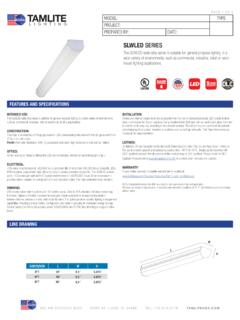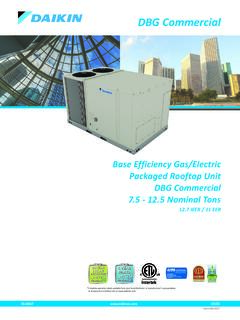Transcription of Introduction Op Amp Topologies Op Amp Structures Op …
1 OP AMP BASICS H Op Amp History 1 Op Amp Basics 1 Introduction 2 Op Amp Topologies 3 Op Amp Structures 4 Op Amp Specifications 5 Precision Op Amps 6 High Speed Op Amps 2 Specialty Amplifiers 3 Using Op Amps with Data Converters 4 Sensor Signal Conditioning 5 Analog Filters 6 Signal Amplifiers 7 Hardware and Housekeeping Techniques OP AMP APPLICATIONS OP AMP BASICS CHAPTER 1: OP AMP BASICS James Bryant, Walt Jung, Walt Kester Within Chapter 1, discussions are focused on the basic aspects of op amps. After a brief introductory section, this begins with the fundamental topology differences between the two broadest classes of op amps, those using voltage feedback and current feedback.
2 These two amplifier types are distinguished more by the nature of their internal circuit Topologies than anything else. The voltage feedback op amp topology is the classic structure, having been used since the earliest vacuum tube based op amps of the 1940 and 1950 s, through the first IC versions of the 1960 s, and includes most op amp models produced today. The more recent IC variation of the current feedback amplifier has come into popularity in the mid-to-late 1980 s, when higher speed IC op amps were developed. Factors distinguishing these two op amp types are discussed at some length.
3 Details of op amp input and output Structures are also covered in this chapter, with emphasis how such factors potentially impact application performance. In some senses, it is logical to categorize op amp types into performance and/or application classes, a process that works to some degree, but not altogether. In practice, once past those obvious application distinctions such as "high speed" versus "precision," or "single" versus "dual supply," neat categorization breaks down. This is simply the way the analog world works. There is much crossover between various classes, , a high speed op amp can be either single or dual-supply, or it may even fit as a precision type.
4 A low power op amp may be precision, but it need not necessarily be single-supply, and so on. Other distinction categories could include the input stage type, such as FET input (further divided into JFET or MOS, which in turn are further divided into NFET or PFET and PMOS and NMOS, respectively), or bipolar (further divided into NPN or PNP). Then, all of these categories could be further described in terms of the type of input (or output) stage used. So, it should be obvious that categories of op amps are like an infinite set of analog gray scales; they don t always fit neatly into pigeonholes, and we shouldn t expect them to.
5 Nevertheless, it is still very useful to appreciate many of the aspects of op amp design that go into the various Structures , as these differences directly influence the optimum op amp choice for an application. Thus structure differences are application drivers, since we choose an op amp to suit the nature of the application, for example single-supply. In this chapter various op amp performance specifications are also discussed, along with those specification differences that occur between the broad distinctions of voltage or current feedback Topologies , as well as the more detailed context of individual Structures .
6 Obviously, op amp specifications are also application drivers, in fact they are the most important, since they will determine system performance. We choose the best op amp to fit the application, based on for the required bias current, bandwidth, distortion, etc. OP AMP APPLICATIONS OP AMP BASICS Introduction SECTION 1: Introduction Walt Jung As a precursor to more detailed sections following, this introductory chapter portion considers the most basic points of op amp operation. These initial discussions are oriented around the more fundamental levels of op amp applications.
7 They include: Ideal Op Amp Attributes, Standard Op Amp Feedback Hookups, The Non-Ideal Op Amp, Op amp Common Mode Dynamic Range(s), the various Functionality Differences of Single and Dual-Supply Operation, and the Device Selection process. Before op amp applications can be developed, some first requirements are in order. These include an understanding of how the fundamental op amp operating modes differ, and whether dual-supply or single-supply device functionality better suits the system under consideration. Given this, then device selection can begin and an application developed.
8 Figure 1-1: The ideal op amp and its attributes First, an operational amplifier (hereafter simply op amp) is a differential input, single ended output amplifier, as shown symbolically in Figure 1-1. This device is an amplifier intended for use with external feedback elements, where these elements determine the resultant function, or operation. This gives rise to the name "operational amplifier," denoting an amplifier that, by virtue of different feedback hookups, can perform a variety of At this point, note that there is no need for concern with any actual technology to implement the amplifier.
9 Attention is focused more on the behavioral nature of this building block device. An op amp processes small, differential mode signals appearing between its two inputs, developing a single ended output signal referred to a power supply common terminal. Summaries of the various ideal op amp attributes are given in the figure. While real op amps will depart from these ideal attributes, it is very helpful for first-level understanding of op amp behavior to consider these features. Further, although these initial discussions 1 The actual naming of the operational amplifier occurred in the classic Ragazinni, et al paper of 1947 (see Reference 1).
10 However analog computations using op amps as we know them today began with the work of the Clarence Lovell led group at Bell Labs, around 1940 (acknowledged generally in the Ragazinni paper). OP AMPOP AMP INPUTS:OP AMP OUTPUT: High Input Impedance Low Bias Current Respond to Differential Mode Voltages Ignore Common Mode Voltages Low Source ImpedanceIDEAL OP AMP ATTRIBUTES: Infinite Differential Gain Zero Common Mode Gain Zero Offset Voltage Zero Bias CurrentOUTPUTPOSITIVE SUPPLYNEGATIVE SUPPLYINPUTS(+)(-) OP AMP APPLICATIONS talk in idealistic terms, they are also flavored by pointed mention of typical "real world" specifications for a beginning perspective.











